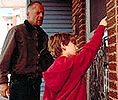
Directed by Harold Becker

Directed by Harold Becker
Review by Todd Vaziri
Bruce Willis stars in this thriller set in Chicago about an autistic boy who has cracked a top secret military defense code. The film contains about 150 visual effects shots, completed by Industrial Light & Magic. Three major sequences populate the majority of ILM's shots: an elevated subway train (the 'El') narrowly misses the autistic boy, Simon; a fight on the El; and the rooftop confrontation between Willis and bad guy Alec Baldwin.
While there are a handful of effects shots that will go completely unnoticed, some of ILM's effects are uncharacteristically mediocre, with frequent glaring inconsistencies and cues that cause the audience to realize the shot is a composite of some sort.
The shots of the approaching El train are extremely successful--complicated 2D splitscreen work was accomplished to put the boy in the path of the oncoming train. The best shot is undoubtedly the steadicam shot of Willis grabbing the boy just as the train passes. What makes the shot work is the fluid and naturalistic camera movement. The shot was photographed with Willis grabbing the boy, of course, without the dangerous train nearly hitting them. The train is a 3D element matchmoved to the "While there are a handful of effects shots that will go completely unnoticed, some of ILM's effects are uncharacteristically mediocre."
In another scene, Willis and a hitman get in a fistfight between two El trains while the train is in motion. This is where the compositing inconsistencies are the most apparent, with varying element edges and wildly inconsistent black levels. The actor elements, which were shot bluescreen, were composited against various blurred backgrounds of the city whizzing by. Although some shots are dynamic and well executed, the sequence seems stilted and wooden. Bluescreen elements sometimes have razor sharp edges, even while elements move at fast speeds (where motion blur should make the edges soft and blurry), and sometimes they have a uniform blurry edge, even while elements are remaining relatively still. Probably most jarring are the two levels of darkness that exist in some shots--the foreground element goes to black at a slighly different level than the background. This phenomena does not occur in normal photography, and it reveals the true, manufactured nature of the shot.
An oddly interesting shot takes place later in the film, with another hitman being showered with shattered glass. Running toward the camera in an overcranked, slow motion shot, the unfortunate man's face becomes riddled with cuts and blood. Most likely put together with a series of subtle dissolves and morphs, the shot is a bit goofy (in that so much action happens in one shot) yet visually interesting.
ILM's duties also included the animation and compositing of an almost unnoticeable CG helicopter into a number of shots, as well as some subtle digital matte paintings to extend the scope of the film.
Official Web Site: http://www.universalpictures.com/
 Visual Effects Produced by:
Visual Effects Produced by:
INDUSTRIAL LIGHT & MAGIC
Visual Effects Supervisor: Michael Owens
Co-VFX Supervisor: George Murphy
VFX Producer : Tom Kennedy
camera movement, with the actors isolated via rotoscoping to make the train appear behind them.

. . VFX HQ Produced by Todd Vaziri . . http://www.vfxhq.com . . e-mail: tvaziri@gmail.com . .
All text Copyright © 1998 Todd Vaziri, unless otherwise noted